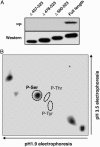Regulation of SR-BI protein levels by phosphorylation of its associated protein, PDZK1
- PMID: 16174736
- PMCID: PMC1224665
- DOI: 10.1073/pnas.0506679102
Regulation of SR-BI protein levels by phosphorylation of its associated protein, PDZK1
Abstract
Scavenger receptor class B type I (SR-BI) is a high-density lipoprotein (HDL) receptor that mediates the selective uptake of HDL cholesterol and cholesterol secretion into bile in the liver. Previously, we identified an SR-BI-associated protein, termed PDZK1, from rat liver membrane extracts. PDZK1 contains four PSD-95/Dlg/ZO-1 (PDZ) domains, the first of which in the N-terminal region is responsible for the association with SR-BI. PDZK1 controls hepatic SR-BI expression in a posttranscriptional fashion both in cell culture and in vivo. In this study, we demonstrated that the C-terminal region of PDZK1 is crucial for up-regulating SR-BI protein expression. Metabolic labeling experiments and phosphoamino acid analysis revealed that PDZK1 is phosphorylated at Ser residues within this region. Point-mutation analysis demonstrated that PDZK1 is phosphorylated at Ser-509. Interestingly, a mutant PDZK1, in which Ser-509 was replaced with Ala, lost the ability to up-regulate SR-BI protein. We identified Ser-509 of PDZK1 as the residue that is phosphorylated by the cAMP-dependent PKA in vitro as well as in cell culture. Ser-509 of PDZK1 in rat liver was also phosphorylated, as shown by an Ab that specifically detects phosphorylated Ser-509. Administration of glucagon to Wistar rats increased PDZK1 phosphorylation as well as hepatic SR-BI and PDZK1 expression while it decreased plasma HDL levels, indicating that PDZK1 phosphorylation is hormonally regulated. These findings suggest that phosphorylation of PDZK1 has an important role in the regulation of hepatic SR-BI expression and, thus, influences plasma HDL levels.
Figures







Similar articles
-
The role of human and mouse hepatic scavenger receptor class B type I (SR-BI) in the selective uptake of low-density lipoprotein-cholesteryl esters.Biochemistry. 2003 Jun 24;42(24):7527-38. doi: 10.1021/bi026949a. Biochemistry. 2003. PMID: 12809509
-
The scavenger receptor class B type I adaptor protein PDZK1 maintains endothelial monolayer integrity.Circ Res. 2008 Feb 29;102(4):480-7. doi: 10.1161/CIRCRESAHA.107.159079. Epub 2008 Jan 3. Circ Res. 2008. PMID: 18174467
-
Scavenger receptor class B type I mediates the selective uptake of high-density lipoprotein-associated cholesteryl ester by the liver in mice.Arterioscler Thromb Vasc Biol. 2005 Jan;25(1):143-8. doi: 10.1161/01.ATV.0000149381.16166.c6. Epub 2004 Nov 4. Arterioscler Thromb Vasc Biol. 2005. PMID: 15528479
-
Influence of the HDL receptor SR-BI on lipoprotein metabolism and atherosclerosis.Arterioscler Thromb Vasc Biol. 2003 Oct 1;23(10):1732-8. doi: 10.1161/01.ATV.0000091363.28501.84. Epub 2003 Aug 14. Arterioscler Thromb Vasc Biol. 2003. PMID: 12920050 Review.
-
Regulation of SR-BI-mediated high-density lipoprotein metabolism by the tissue-specific adaptor protein PDZK1.Curr Opin Lipidol. 2005 Apr;16(2):147-52. doi: 10.1097/01.mol.0000162319.54795.e5. Curr Opin Lipidol. 2005. PMID: 15767854 Review.
Cited by
-
Carbachol-induced MUC17 endocytosis is concomitant with NHE3 internalization and CFTR membrane recruitment in enterocytes.Am J Physiol Cell Physiol. 2013 Aug 15;305(4):C457-67. doi: 10.1152/ajpcell.00141.2013. Epub 2013 Jun 19. Am J Physiol Cell Physiol. 2013. PMID: 23784542 Free PMC article.
-
Alterations in the proteome of the NHERF1 knockout mouse jejunal brush border membrane vesicles.Physiol Genomics. 2010 Nov 15;42A(3):200-10. doi: 10.1152/physiolgenomics.00001.2010. Epub 2010 Aug 24. Physiol Genomics. 2010. PMID: 20736413 Free PMC article.
-
D-AKAP2 interacts with Rab4 and Rab11 through its RGS domains and regulates transferrin receptor recycling.J Biol Chem. 2009 Nov 20;284(47):32869-80. doi: 10.1074/jbc.M109.022582. Epub 2009 Sep 21. J Biol Chem. 2009. PMID: 19797056 Free PMC article.
-
PDZK1 prevents neointima formation via suppression of breakpoint cluster region kinase in vascular smooth muscle.PLoS One. 2015 Apr 17;10(4):e0124494. doi: 10.1371/journal.pone.0124494. eCollection 2015. PLoS One. 2015. PMID: 25886360 Free PMC article.
-
Interaction of the human prostacyclin receptor with the PDZ adapter protein PDZK1: role in endothelial cell migration and angiogenesis.Mol Biol Cell. 2011 Aug 1;22(15):2664-79. doi: 10.1091/mbc.E11-04-0374. Epub 2011 Jun 8. Mol Biol Cell. 2011. PMID: 21653824 Free PMC article.
References
-
- Gordon, D. J. & Rifkind, B. M. (1989) N. Engl. J. Med. 321, 1311-1316. - PubMed
-
- Barter, P. J. & Rye, K. A. (1996) Atherosclerosis 121, 1-12. - PubMed
-
- Fielding, C. J. & Fielding, P. E. (1995) J. Lipid Res. 36, 211-228. - PubMed
-
- Wang, M. & Briggs, M. R. (2004) Chem. Rev. 104, 119-137. - PubMed
-
- Trigatti, B., Rigotti, A. & Krieger, M. (2000) Curr. Opin. Lipidol. 11, 123-131. - PubMed
MeSH terms
Substances
LinkOut - more resources
Full Text Sources
Molecular Biology Databases
Research Materials

